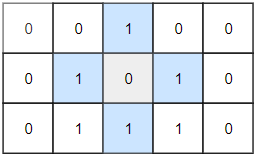Leetcode 1254. Number of Closed Islands
Leetcode 1254. Number of Closed Islands
Given a 2D grid consists of 0s (land) and 1s (water). An island is a maximal 4-directionally connected group of 0s and a closed island is an island totally (all left, top, right, bottom) surrounded by 1s.
Return the number of closed islands.
Example 1:

Input: grid = [[1,1,1,1,1,1,1,0],[1,0,0,0,0,1,1,0],[1,0,1,0,1,1,1,0],[1,0,0,0,0,1,0,1],[1,1,1,1,1,1,1,0]]
Output: 2
Explanation:
Islands in gray are closed because they are completely surrounded by water (group of 1s).
Example 2:

Input: grid = [[0,0,1,0,0],[0,1,0,1,0],[0,1,1,1,0]]
Output: 1
Example 3:
Input: grid = [[1,1,1,1,1,1,1],
[1,0,0,0,0,0,1],
[1,0,1,1,1,0,1],
[1,0,1,0,1,0,1],
[1,0,1,1,1,0,1],
[1,0,0,0,0,0,1],
[1,1,1,1,1,1,1]]
Output: 2
Constraints:
1 <= grid.length, grid[0].length <= 100
0 <= grid[i][j] <=1
solution
需要找出四周环水的岛屿数量,在边界处的岛屿不能算四周环水,所以先把四周的岛屿变成水,在按照Leetcode 200. Number of Islands的方法处理就好了
class Solution {
public:
int closedIsland(vector<vector<int>>& grid) {
if (grid.empty())
return 0;
int n = grid.size();
int m = grid[0].size();
for(int i = 0; i < n; i++)
for(int j = 0; j < m; j++)
if(grid[i][j] == 0 && (i == 0 || j == 0 || i == (n-1) || j == (m-1)))
DFS(grid, i, j, n, m);
int ans = 0;
for (int i = 0; i < n; i++)
for (int j = 0; j < m; j++)
{
if (grid[i][j] == 0)
{
ans++;
DFS(grid, i, j, n, m);
}
}
return ans;
}
void DFS(vector<vector<int>>& grid, int i, int j, int n, int m)
{
if (i < 0 || j < 0 || i >= n || j >= m || grid[i][j] == 1)
return;
grid[i][j] = 1;
DFS(grid, i + 1, j, n, m);
DFS(grid, i - 1, j, n, m);
DFS(grid, i, j + 1, n, m);
DFS(grid, i, j - 1, n, m);
}
};
参考链接
blogs record our growth



 浙公网安备 33010602011771号
浙公网安备 33010602011771号